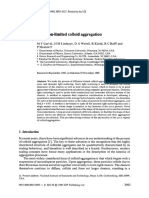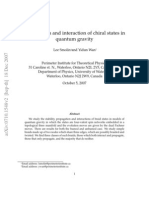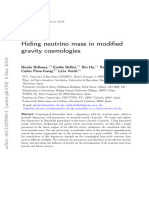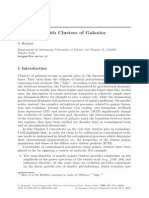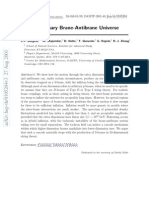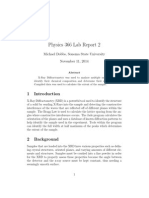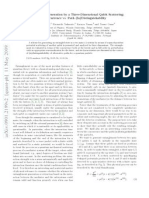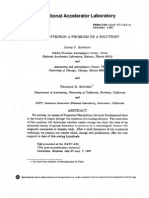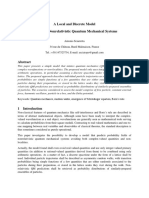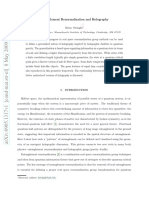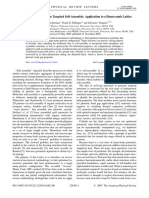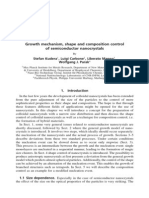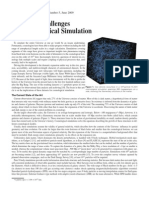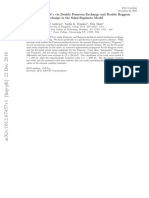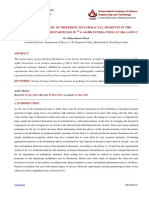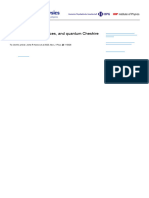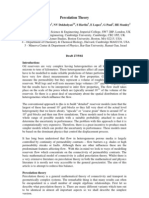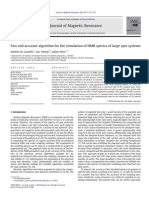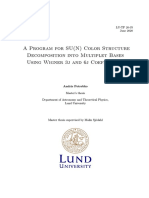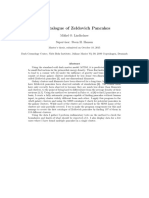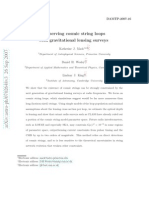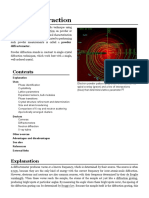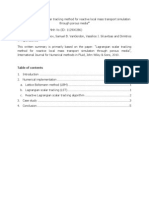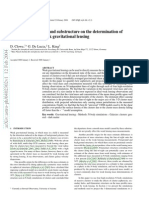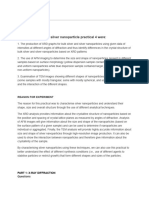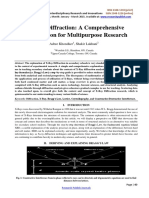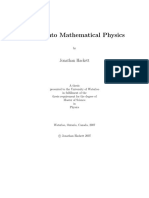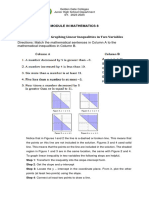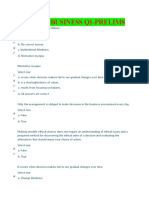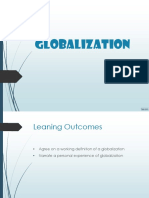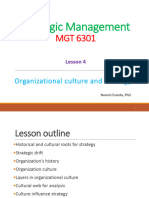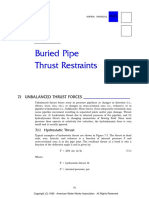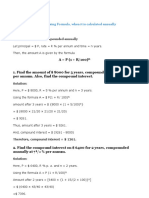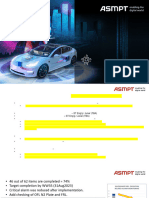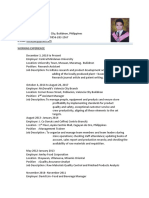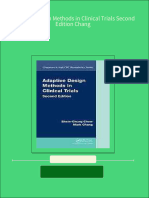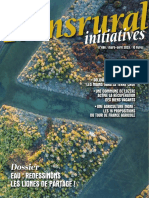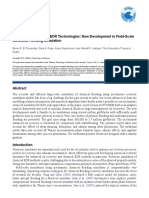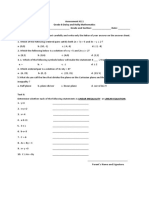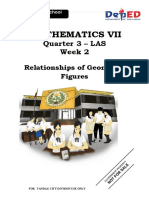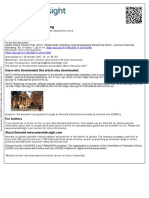Department of Physics College of Natural and Computational Sciences Addis Ababa University
Department of Physics College of Natural and Computational Sciences Addis Ababa University
Uploaded by
Henock TadeleCopyright:
Available Formats
Department of Physics College of Natural and Computational Sciences Addis Ababa University
Department of Physics College of Natural and Computational Sciences Addis Ababa University
Uploaded by
Henock TadeleOriginal Title
Copyright
Available Formats
Share this document
Did you find this document useful?
Is this content inappropriate?
Copyright:
Available Formats
Department of Physics College of Natural and Computational Sciences Addis Ababa University
Department of Physics College of Natural and Computational Sciences Addis Ababa University
Uploaded by
Henock TadeleCopyright:
Available Formats
DEPARTMENT OF PHYSICS
College of NATURAL AND COMPUTATIONAL SCIENCEs
Addis ababa university
Physics 606
COMPUTATIONAL PHYSICS
PROJECT REPORT
REACTION LIMITED AGGREGATION
Date of submission: July, 13,2023
Group No: 1
Group Members
Name ID No
1. Henock Tadele GSR/5543/15
2. Abera Gudesa GSR/9131/15
Name of Instructor: Dr. Tatek Y.
Reaction Limited Aggregation
Abstract
In this project, we have investigated the reaction-limited aggregation (RLA) using the Metropolis Monte Carlo
Simulation method. We have simulated this diffusion phenomena for two distinct cases, for and
. The corresponding fractal structures were determined using GNUPlot software. Furthermore, we
have determined the respective fractal dimensions for both scenarios by plotting ( ) ( ) and taking
the slope of the linear section of the graph. The results were for and for
. These values were inconsistent with other experimental results; hence we investigated the
relationship between sticking probability constant and fractal dimension . From such experiment, we
found that had a decaying exponential relation. Therefore, it is expected that as
exponentially.
Introduction
Significant advances in our understanding of irreversible, kinetic colloid aggregation have been made in the
past several years. The structure of the colloidal aggregates has shown to be scale invariant, so that it can be
characterized as a fractal, allowing more detailed study of the process of aggregation and the relationship of
the cluster structure to the aggregation kinetics. Two limiting regimes of kinetics have been identified: rapid,
diffusion-limited (DLCA) and slow, reaction-limited (RLCA) colloid aggregation. Each regime exhibits
distinct behavior, characterized by the fractal dimension of the clusters, the shape of the cluster mass
distribution and the kinetics of aggregation. These two classes of aggregation are limiting regimes of the
kinetics, both rapid and slow and intermediate regimes of aggregation can often be described by a crossover
behavior between the two limits. This suggests that DLCA and RLCA may be sufficient to describe the full
range of kinetics of aggregation.[1]
The key to understanding colloidal aggregation is the behavior of the energy of interaction between two
approaching particles. Being more specific, the repulsive energy barrier between these particles plays
important role in the study of such interaction. If the height of this energy barrier is sufficiently larger than
, the particles will be unable to stick to one another when their diffusive motion causes them to collide.
Aggregation can only occur when the height of the barrier is reduced. If is reduced to much less than ,
every collision will result in the particles sticking together, leading to very rapid aggregation, limited only by
the rate of diffusion-induced collisions between clusters. This regime is called diffusion-limited colloid
aggregation. By contrast, if remains comparable to, or larger than , many collisions must occur before
two particles can stick to one another. In this case, the aggregation rate is limited by the probability of
overcoming the repulsive barrier ( ⁄ ), leading to much slower aggregation. This regime is
called reaction-limited colloid aggregation. In each case, however, as particles stick together to become
clusters, the clusters themselves continue to diffuse, collide and aggregate. Thus both types are examples of
cluster-cluster aggregation. Moreover, in either case, the strength of the resultant bonds are much larger than
, so the aggregation is irreversible and the clusters formed are rigid.[1]
The French mathematician Mandelbrot raised the concept of fractal in the 1970s. In his paper How long is the
coast of Britain? Statistical self-similarity and fractional dimension, he revealed the truth that most of the
natural objects are so complex and erratic that cannot be described well in terms of simple primitives. And
those complex objects present strong self-similarity. From his point of view, the coastline is the very
representative example of a fractal, which exhibits accurate or statistical self-similarity. Moreover, He pointed
out that the self-similarity is the core feature of fractals, which means fractal objects can be subdivided into
Reaction Limited Aggregation | 1
many parts, each of them may be a small scale copy of the whole, or they are similar in statistics at least. Thus
more and more scholars tend to take fractal dimension (or Hausdorff dimension) as the indicator to describe
the degree of self-similarity and complexity in geometry.[2] A fractal is a geometric shape containing detailed
structure at arbitrarily small scales. Such structures (for example, Lichtenberg Figures, lightening) are usually
described by the fractal dimension , which is an index for characterizing fractal patterns or sets by
quantifying their complexity as a ratio of the change in detail to change in scale. The fractal dimension for
DLCA is usually whereas, for RLCA ranges between (certain experiments may have
higher or lower values).
Simulation Method
The simulation method used in this project is the so called Metropolis-Hastings Monte Carlo Algorithm. It is
a method for obtaining a sequence of random samples from a probability distribution from which direct
sampling is difficult. The algorithm is named in part for Nicholas Metropolis, the first coauthor of a 1953
paper, entitled Equation of State Calculations by Fast Computing Machines, with Arianna W. Rosenbluth,
Marshall Rosenbluth, Augusta H. Teller and Edward Teller. The Metropolis–Hastings algorithm can draw
samples from any probability distribution with probability density ( ) provided that we know a function
( ) proportional to the density and the values of ( ) can be calculated. The requirement that ( ) must
only be proportional to the density, rather than exactly equal to it, makes the Metropolis–Hastings algorithm
particularly useful, because calculating the necessary normalization factor is often extremely difficult in
practice. The Metropolis–Hastings algorithm generates a sequence of sample values in such a way that, as
more and more sample values are produced, the distribution of values more closely approximates the desired
distribution. These sample values are produced iteratively, with the distribution of the next sample being
dependent only on the current sample value, thus making the sequence of samples into a Markov chain.
Specifically, during each iteration, the algorithm picks a candidate for the next sample value based on the
current sample value. Then, with some probability, the candidate is either accepted, in which case the
candidate value is used in the next iteration or it is rejected in which case the candidate value is discarded, and
current value is reused in the next iteration. The probability of acceptance is determined by comparing the
values of the function ( ) of the current and candidate sample values with respect to the desired
distribution.[3]
In the appendix, the code for the simulation of the RLCA is present which outputs two files “fractal.txt” and
“plot.txt”. The former text file allows us to visualize the fractal structure for a particular sticking probability
constant . While the latter text file enables us to determine the fractal dimension by determining the
number of particles contained in a box of side length .
Figure 1 shows this by drawing concentric circles of varying radii from
the center particle, however, without affecting the value of to higher
degree we used squares of varying sides centered on the initial seed
particle placed at the center of the simulation box.
Figure 1 Mechanism for counting the number of particles
Reaction Limited Aggregation | 2
First we begun by constructing a square simulation box of side length . Next we drew two
concentric circles of as shown below. We then placed a particle at the center of our simulation
box. We then launched a new particle from distance away from the center, and this diffusing particle
exhibited a random walk motion. Depending on its energy and the probability where is the
number of newly created connections between the particle and the cluster, it has two instances: this particle
will collide with the seed particle at the center and stick to it or the particle will through Brownian motion
“escape” the bounding circle with radius , in which case it is discarded and another new particle is
launched. This process was repeated until a predefined cluster size was reached. Concerning the
tracking of the positions of the particles, a was used with jump vectors since we are
considering a lattice structure where each neighboring lattice sites are apart, assuming the center
seed particle (black) to be located at the origin. The cluster is grown with a iteration loop and
appropriate conditions are used in the code with self-explanatory comments in bold.
Figure 2 Simulation of Diffusion
Differences between DLCA and RLCA from the code is the condition ( () ). The ()
function generates random numbers between 0 and 1, if the number generated is less than the product of
“ ” and (number of neighboring particles, has values 0, 1, 2 or 3) then the particle is accepted,
representing an RLCA. However, such condition is not present in simulating DLCA and is assumed that when
is greater than 1 then the RLCA approaches DLCA type.
N.B: A Monte Carlo step ( ) is not used in such simulation since the process is irreversible where if a
particle collides and sticks to another then it can’t be unstuck.
Determination of
We first determined the number of particles as a function of the side length ( ), and used the following
equation to determine the fractal dimension .
( )
where we see that ( ( ))⁄ ( )
After obtaining the “plot.txt” file containing ( ), we imported these values into MS-Excel. However,
beyond some value of , the number of particles remained constant as it is apparent in
the log-log plots in the result section. Hence, we only took the values of the linear trend followed by
Reaction Limited Aggregation | 3
determining the natural logarithm of those values and fitted the points using a scatter plot and a linear trend
line. The slope of the linear trend line is an approximated value of by which Excel employs linear least
square fit method.
Results
Part i) Reaction-limited aggregation for
Figure 3 RLA Fractal structure for
(Plotted using GNUPlot)
log(N) vs. log(R) for a=0.2
9
8
7
6
log(N)
5
4
3
2
1
0
0 1 2 3 4 5 6
log(R)
Graph 1 log(N) vs. log(R) for
Reaction Limited Aggregation | 4
log(N) vs. log(R) for a=0.2
9
8
7
6
log(N) = 1.5132log(R) + 1.8741
log(N)
5 R² = 0.9522
4
3
2
1
0
0 1 2 3 4 5
log(R)
Graph 2 Linear Plot of log-log curve for
Part ii) Reaction-limited aggregation for
Figure 4 RLA Fractal structure for
(Plotted using GNUPlot)
Reaction Limited Aggregation | 5
log(N) vs. log(R) for a=0.9
9
8
7
6
log(N)
5
4
3
2
1
0
0 1 2 3 4 5 6
log(R)
Graph 3 log(N) vs. log(R) for
10
log(N) vs. log(R) for a=0.9
9
8
7
6
log(N)= 1.5146log(R) + 1.5259
log(N)
5 R² = 0.9793
4
3
2
1
0
0 1 2 3 4 5
log(R)
Graph 4 Linear Plot of log-log curve for
Reaction Limited Aggregation | 6
Table 1 Investigation of relationship between and
a vs. df
2.4
2.2
Fractal Dimension,df
1.8
1.6
1.4
1.2
1
0 0.2 0.4 0.6 0.8 1
Sticking Probability, a
Graph 5 Investigating the relation between
Discussion
In this project we have simulated RLCA for and . We have obtained the fractal structure as
shown in figure 3 and figure 4. Comparing these images, we can see that the fractal branches are more
“extending” and more closely packed, “hairy” or solid for . A good indicator for this would have been
to obtain a higher fractal dimension for than for . The determination of the fractal dimension
was done by first plotting ( ) ( ), where we only considered the linear section of the curve and
used Excel to determine the slope. We have obtained with fit correlation coefficient R² =
0.9522, and with R² = 0.9793. Since our experimental investigation didn’t agree with
previous findings we had to explore the relationship between by altering the value of in the code
and obtaining the fractal dimension values for each. Table 1 represents the values of we have
considered and again Excel was used to obtain the slope or We have observed a decaying exponential
curve and have expected the ( ) to be greater than ( ), however, using the log-log plots in
graphs 2 and 4 we saw that this was not the case. The plot in graph 5, shows that as , the value of
Reaction Limited Aggregation | 7
approaches some constant value, which explains why fractal dimension of and differ only by
the thousandth digit place.
Conclusion
In this project, we have explored cluster-cluster aggregation of diffusing particles more specifically the
reaction-limited colloid aggregation using the Metropolis Monte Carlo Simulation Method. We have
considered two distinct cases by varying the sticking probability constant and for a
predefined total number of particles . The two main objectives were to visualize the fractal structure
and determination of the fractal dimension . From the simulation for , we have obtained
and for . These results indicate that the as . However, this
contradicts previous experimental results (Souradeep Ghosh et al, Effect of free energy barrier on pattern
transition in 2D DLA morphology of electrodeposited copper, 2018). Following these results, we set out to
look into the connection between and . After plotting the graph, we found a decaying exponential
regression showing that as exponentially. Possible solutions to alleviate this
contradiction might be to consider larger value of N or use a computer with better clock speed.
References
1. M.Y. Lin; H.M. Lindsay et al, Universal Reaction Limited Colloid Aggregation, Physical Review,
Volume 41, Number 4, 1990
2. Jiaxin Wu; Xin Jin et al, An Effective Method to compute the Box-counting Dimension based on the
Mathematical Definitions and Intervals, Results in Engineering, 2000
3. Kalos, Malvin H; Whitlock, Paula A, Monte Carlo Methods Volume I: Basics, New York, Wiley
pp 78-88, 1986
Reaction Limited Aggregation | 8
Appendix (Code Used)
!Reaction limited aggregation simulation on a 2D lattice
integer, parameter:: ncluster = 4000,lx=220, ly=220, rint = 200, rext = rint + 10
integer, dimension(ncluster):: x, y
double precision, parameter:: ck = 2d-1!a, this is the value to be altered
integer, dimension(-lx:lx, -ly:ly):: pos
integer,dimension(lx)::nc
integer, dimension(4):: jx, jy
integer :: i, j, k, xt, yt, stick, s
double precision:: theta, pi,d
!Add seed generator !Neighbor test
call generate_seed(i) s=0
i=ran(i) s = pos(xt+1,yt) + pos(xt,yt+1) + pos(xt-1,yt) +
pos(xt,yt-1)
!Jump Vectors
jx(1) = 1; jy(1) = 0 if(s.gt.0) then
jx(2) = -1; jy(2) = 0 if(ran().lt.ck*s) then
jx(3) = 0; jy(3) = 1 !Accept position
jx(4) = 0; jy(4) = -1 i=i+1
x(i) = xt
pos = 0 y(i) = yt
pi = acos(-1d0) pos(x(i),y(i)) = 1
stick = 1
!Place the seed particle at the center endif
x(1) = 0 endif
y(1) = 0
pos(x(1),y(1)) = 1 enddo !End diffusion loop
!Start growing cluster enddo !End cluster growth
i=1
do while(i.lt.ncluster) open(10, file='fractal.txt', status='unknown')
theta = ran()*2*pi do i = 1, ncluster
xt = rint*cos(theta) write(10,*)x(i), y(i)
yt = rint*sin(theta) enddo
!Plot
!Start diffusing particle nc=0
stick = 0 nc(1)=1!only center particle contianed in the first
do while(stick.eq.0) square
!Choose a direction at random i=1
k = ran()*4 + 1 do while(i<lx)
xt = xt + jx(k) i=i+1
yt = yt + jy(k) do j=-i,i
!Dump particle if beyond outer circle do k=-i,i
d = xt**2 + yt**2 nc(i)= nc(i) + pos(j,k)
if(d.gt.rext**2) exit end do
end do
Reaction Limited Aggregation | 9
end do !***************************************
subroutine generate_seed(seed)
open(11,file='plot.txt',status='unknown') integer::seed
do i = 1, lx integer, dimension(3)::t
write(11,*) i, nc(i)
call itime(t)
enddo
end seed=487*t(1)+5645*t(2)+776896*t(3)
end
Reaction Limited Aggregation | 10
You might also like
- QTM-Pressure Operations ManualDocument68 pagesQTM-Pressure Operations ManualRizwan FaridNo ratings yet
- Universal Diffusion-Limited Colloid Aggregation: H DA R RC P TDocument22 pagesUniversal Diffusion-Limited Colloid Aggregation: H DA R RC P TFahriNo ratings yet
- Nonlocality in Granular Complex Networks Linking Topology, Kinematics and ForcesDocument16 pagesNonlocality in Granular Complex Networks Linking Topology, Kinematics and Forcesking sunNo ratings yet
- Nicholas Jones, Horace Stoica and S.-H. Henry Tye - Brane Interaction As The Origin of InflationDocument29 pagesNicholas Jones, Horace Stoica and S.-H. Henry Tye - Brane Interaction As The Origin of InflationHuntsmithNo ratings yet
- An Introduction To The Density Matrix Renormalization Group Ansatz in Quantum ChemistryDocument18 pagesAn Introduction To The Density Matrix Renormalization Group Ansatz in Quantum ChemistryAbhijit SamantaNo ratings yet
- Lee Smolin and YidunWan - Propagation and Interaction of Chiral States in Quantum GravityDocument34 pagesLee Smolin and YidunWan - Propagation and Interaction of Chiral States in Quantum GravityMopadDeluxeNo ratings yet
- Hiding Neutrino Mass in Modified Gravity CosmologiesDocument12 pagesHiding Neutrino Mass in Modified Gravity CosmologiesLida Velasquez SierraNo ratings yet
- Gravitational Redshift of Galaxies in Clusters As Predicted by General RelativityDocument23 pagesGravitational Redshift of Galaxies in Clusters As Predicted by General RelativitysfliuNo ratings yet
- 1 s2.0 S0022460X16000407 MainDocument17 pages1 s2.0 S0022460X16000407 MainLexin LINo ratings yet
- 04 X-Ray DiffractionDocument9 pages04 X-Ray DiffractionSampath KumarNo ratings yet
- Dynamics of Galaxies and Clusters of GalaxiesDocument48 pagesDynamics of Galaxies and Clusters of GalaxiespjblkNo ratings yet
- Marc G. Zacher Et Al - Evolution of The Stripe Phase As A Function of Doping From A Theoretical Analysis of Angle-Resolved Photoemission DataDocument9 pagesMarc G. Zacher Et Al - Evolution of The Stripe Phase As A Function of Doping From A Theoretical Analysis of Angle-Resolved Photoemission DataSaqqerNo ratings yet
- Cosmology With Clusters of GalaxiesDocument48 pagesCosmology With Clusters of GalaxiespjblkNo ratings yet
- C.P. Burgess Et Al - The Inflationary Brane-Antibrane UniverseDocument21 pagesC.P. Burgess Et Al - The Inflationary Brane-Antibrane UniverseHuntsmithNo ratings yet
- RFDC SputteringDocument4 pagesRFDC Sputteringसुरेन्द्र वशिष्ठNo ratings yet
- Physics 366 Lab Report 2: Michael Dobbs, Sonoma State University November 11, 2014Document8 pagesPhysics 366 Lab Report 2: Michael Dobbs, Sonoma State University November 11, 2014smoothieboyNo ratings yet
- Entanglement Generation by A Three-Dimensional Qubit Scattering: Concurrence vs. Path (In) DistinguishabilityDocument4 pagesEntanglement Generation by A Three-Dimensional Qubit Scattering: Concurrence vs. Path (In) DistinguishabilityBekir DeveciNo ratings yet
- Raphael Bousso and Stefan Leichenauer - Predictions From Star Formation in The MultiverseDocument69 pagesRaphael Bousso and Stefan Leichenauer - Predictions From Star Formation in The MultiverseGijke3No ratings yet
- How To Get The Yield Locus of An Adhesive Powder From A Single Numerical ExperimentDocument6 pagesHow To Get The Yield Locus of An Adhesive Powder From A Single Numerical Experimentsubhash thakurNo ratings yet
- Fotini Markopoulou and Isabeau Premont-Schwarz - Conserved Topological Defects in Non-Embedded Graphs in Quantum GravityDocument43 pagesFotini Markopoulou and Isabeau Premont-Schwarz - Conserved Topological Defects in Non-Embedded Graphs in Quantum GravityMopadDeluxeNo ratings yet
- Tridimencionalidade QuanticaDocument8 pagesTridimencionalidade Quanticafhenrique77No ratings yet
- 1511 05962 PDFDocument15 pages1511 05962 PDFKleberNevesNo ratings yet
- Adaptive Network Models of Swarm Dynamics: 614 N Paulina ST, Chicago IL 60622, USADocument5 pagesAdaptive Network Models of Swarm Dynamics: 614 N Paulina ST, Chicago IL 60622, USAapi-30347479No ratings yet
- 2018-Efficient GPU-based Monte-Carlo Simulation of Diffusion in Real Astrocytes Reconstructed From Confocal MicrosDocument12 pages2018-Efficient GPU-based Monte-Carlo Simulation of Diffusion in Real Astrocytes Reconstructed From Confocal MicrosnvkhieuNo ratings yet
- David P. Bennett and Francois R. Bouchet - Cosmic Strings: A Problem or A Solution?Document7 pagesDavid P. Bennett and Francois R. Bouchet - Cosmic Strings: A Problem or A Solution?LopmazNo ratings yet
- A Local and Discrete Model Simulating Nonrelativistic Quantum MechanicalDocument26 pagesA Local and Discrete Model Simulating Nonrelativistic Quantum MechanicalAristide PioNo ratings yet
- A Non-Standard Statistical Approach To The Silo Discharge: T E P JDocument8 pagesA Non-Standard Statistical Approach To The Silo Discharge: T E P JA94leo14hsetmaNo ratings yet
- Entanglement Renormalization and Holography: Electronic Address: Bswingle@mit - EduDocument15 pagesEntanglement Renormalization and Holography: Electronic Address: Bswingle@mit - Edubase1No ratings yet
- Optimized Interaction For Targeted Self Assembly Stillinger PRL 2003Document4 pagesOptimized Interaction For Targeted Self Assembly Stillinger PRL 2003keshariNo ratings yet
- QDs ShapeDocument34 pagesQDs ShapeOscar Rojas ValenciaNo ratings yet
- Petascale Challenges For Cosmological Simulation: by Paul RickerDocument3 pagesPetascale Challenges For Cosmological Simulation: by Paul RickerbernasekNo ratings yet
- Central Production of η via Double Pomeron Exchange and Double Reggeon Exchange in the Sakai-Sugimoto ModelDocument32 pagesCentral Production of η via Double Pomeron Exchange and Double Reggeon Exchange in the Sakai-Sugimoto ModelJosef LeutgebNo ratings yet
- Projects 2015Document45 pagesProjects 2015Steven ArcadoNo ratings yet
- Reviewed - Cor - IJAMSS - Comparative Study of Multifractal MomentsDocument18 pagesReviewed - Cor - IJAMSS - Comparative Study of Multifractal Momentsiaset123No ratings yet
- Hance_2023_New_J._Phys._25_113028Document15 pagesHance_2023_New_J._Phys._25_113028ron LlameraNo ratings yet
- Title 1Document26 pagesTitle 1Andreas NeophytouNo ratings yet
- Biological ColisionDocument4 pagesBiological ColisionDemian PereiraNo ratings yet
- Negative and Anomalous Refraction inDocument166 pagesNegative and Anomalous Refraction inDaniel MoránNo ratings yet
- Percolation TheoryDocument10 pagesPercolation Theoryaleemsalman55No ratings yet
- Journal of Magnetic Resonance: Andrés M. Castillo, Luc Patiny, Julien WistDocument8 pagesJournal of Magnetic Resonance: Andrés M. Castillo, Luc Patiny, Julien WistpresatNo ratings yet
- A Program For SU (N) Color Structure Decomposition Into Multiplet Bases Using Wigner 3j and 6j CoefficientsDocument55 pagesA Program For SU (N) Color Structure Decomposition Into Multiplet Bases Using Wigner 3j and 6j CoefficientsPradyumanNo ratings yet
- Quantum Gravity at The Fifth Root of UnityDocument10 pagesQuantum Gravity at The Fifth Root of UnityQuantum Gravity ResearchNo ratings yet
- A Catalogue of Zeldovich Pancakes: Mikkel O. Lindholmer Supervisor: Steen H. HansenDocument34 pagesA Catalogue of Zeldovich Pancakes: Mikkel O. Lindholmer Supervisor: Steen H. Hansenjj1jj2jj3jj4No ratings yet
- Dynamic Simulation of Active and Inactive Chromatin DoaminsDocument14 pagesDynamic Simulation of Active and Inactive Chromatin DoaminsFaylasoofNo ratings yet
- Observing Cosmic String Loops With Gravitational Lensing SurveysDocument20 pagesObserving Cosmic String Loops With Gravitational Lensing SurveysEntropyPrincipleNo ratings yet
- Powder DiffractionDocument9 pagesPowder DiffractionGary TrumpNo ratings yet
- Fractal Geometry and Its Correlation To The Efficiency of BiologiDocument12 pagesFractal Geometry and Its Correlation To The Efficiency of Biologithaidiemquynhht2003No ratings yet
- Topic: "Lagrangian Scalar Tracking Method For Reactive Local Mass Transport SimulationDocument6 pagesTopic: "Lagrangian Scalar Tracking Method For Reactive Local Mass Transport SimulationVo Duc Minh MinhNo ratings yet
- Fractal Structure of Hematite AggregatesDocument11 pagesFractal Structure of Hematite AggregatesEmiliano bálsamoNo ratings yet
- 1963 - Hulburt - Katz - Some Problems in Particle TechnologyDocument20 pages1963 - Hulburt - Katz - Some Problems in Particle TechnologyAnonymous clLZmJNo ratings yet
- Pr146 Ch17 KongDocument12 pagesPr146 Ch17 Kongdavid8055No ratings yet
- 1 3180066Document5 pages1 3180066matias79No ratings yet
- Effects of Asphericity and Substructure On The Determination of Cluster Mass With Weak Gravitational LensingDocument10 pagesEffects of Asphericity and Substructure On The Determination of Cluster Mass With Weak Gravitational LensingEntropyPrincipleNo ratings yet
- Nanoparticles Practical Submission No. 4Document10 pagesNanoparticles Practical Submission No. 4jerryNo ratings yet
- X Ray Diffraction 1057Document5 pagesX Ray Diffraction 1057JohnNo ratings yet
- Karakostas - Limitations On Stochastic Localization Models of State Vector ReductionDocument15 pagesKarakostas - Limitations On Stochastic Localization Models of State Vector Reductionkarakost8903100% (2)
- A Practical Guide To Small Angle X-Ray Scattering (SAXS)Document8 pagesA Practical Guide To Small Angle X-Ray Scattering (SAXS)Guillermo RomeroNo ratings yet
- Projects2017-4 12 PDFDocument54 pagesProjects2017-4 12 PDFRAhul KumarNo ratings yet
- Forays Into Mathematical PhysicsDocument32 pagesForays Into Mathematical PhysicsJohn BirdNo ratings yet
- On the Revolutions of the Internal Spheres: A New Theory of Matter and the Transmission of Light, Second EditionFrom EverandOn the Revolutions of the Internal Spheres: A New Theory of Matter and the Transmission of Light, Second EditionNo ratings yet
- Causa Finalis: Main ArticleDocument4 pagesCausa Finalis: Main ArticleNoemi NadadoNo ratings yet
- Practice Test No. 17: (Adapted From Reading Challenge 1 by Casey Malareher and Andrea Janzen)Document4 pagesPractice Test No. 17: (Adapted From Reading Challenge 1 by Casey Malareher and Andrea Janzen)nguyen ngaNo ratings yet
- 2021 12 HSE Newsletter 1Document2 pages2021 12 HSE Newsletter 1Paola EsparragozaNo ratings yet
- Thin Film Growth - MBE PDFDocument24 pagesThin Film Growth - MBE PDFnuemoonNo ratings yet
- Purple Wildflowers Photo Background SlidesManiaDocument25 pagesPurple Wildflowers Photo Background SlidesManiaLester TambacNo ratings yet
- Excel Formula FunctionDocument80 pagesExcel Formula FunctionPaing Soe ChitNo ratings yet
- Module in Mathematics 8Document7 pagesModule in Mathematics 8HaxProductions 6996No ratings yet
- Сущ. В1-В2Document24 pagesСущ. В1-В2Vladimir ShlykNo ratings yet
- ETHICSBUSINESSQ1TOPRELIMSDocument16 pagesETHICSBUSINESSQ1TOPRELIMSpark se yeonNo ratings yet
- Biological Hazard Radio ScriptDocument2 pagesBiological Hazard Radio ScriptLilianna100% (1)
- De Thi Hoc Ky 2 Mon Tieng Anh Lop 10 Co Dap AnDocument18 pagesDe Thi Hoc Ky 2 Mon Tieng Anh Lop 10 Co Dap AnHiếu Nguyễn MinhNo ratings yet
- Lesson 1 What Is GlobalizationDocument34 pagesLesson 1 What Is GlobalizationJOZEL CULANGANNo ratings yet
- Lesson 4 - Organizational Culture and StrategyDocument32 pagesLesson 4 - Organizational Culture and StrategysurangauorNo ratings yet
- Thrust Block DesignDocument12 pagesThrust Block DesignJorge Castro Cucurella100% (1)
- National Service Training Program: Learner's GuideDocument13 pagesNational Service Training Program: Learner's GuideDaryl A. Dela CruzNo ratings yet
- Field Study 1-Episode 6Document6 pagesField Study 1-Episode 6chuboy gonzagaNo ratings yet
- ATTACH 02 - SCHOOL Guide For WinS 3 Star ApproachDocument6 pagesATTACH 02 - SCHOOL Guide For WinS 3 Star ApproachJasmin RayosNo ratings yet
- Ee1 2017Document27 pagesEe1 2017Shivakumar 2108No ratings yet
- Compound Interest by Using FormulaDocument5 pagesCompound Interest by Using FormulaAysha FidaNo ratings yet
- ST BSK SilverSAM Oxidation Update 9Aug2023Document16 pagesST BSK SilverSAM Oxidation Update 9Aug2023soufianemr707No ratings yet
- Kierby B. DepalanDocument3 pagesKierby B. DepalanKierby DepalanNo ratings yet
- Cottagecore Aesthetic Style Thesis by SlidesgoDocument45 pagesCottagecore Aesthetic Style Thesis by SlidesgoKIARA ARIASNo ratings yet
- Ebooks File Adaptive Design Methods in Clinical Trials Second Edition Chang All ChaptersDocument84 pagesEbooks File Adaptive Design Methods in Clinical Trials Second Edition Chang All Chapterssawudesethia100% (13)
- Effect of Cartoons On Childrens Behaviour in IndiaDocument26 pagesEffect of Cartoons On Childrens Behaviour in IndiaVivek MugdalNo ratings yet
- Transrural Initiatives N°496Document10 pagesTransrural Initiatives N°496TransruralNo ratings yet
- OTC-29287-MS Advances in Chemical EOR Technologies: New Development in Field-Scale Chemical Flooding SimulationDocument28 pagesOTC-29287-MS Advances in Chemical EOR Technologies: New Development in Field-Scale Chemical Flooding SimulationVeronicaNo ratings yet
- Assessment in Math 8 1 and 2 (2ND Quarter)Document2 pagesAssessment in Math 8 1 and 2 (2ND Quarter)daneca teogancoNo ratings yet
- Enhanced Mathematics Q3-LAS Week 2Document11 pagesEnhanced Mathematics Q3-LAS Week 2mia laordenNo ratings yet
- Relationship MarketingDocument6 pagesRelationship MarketingKhoirul MunaNo ratings yet

